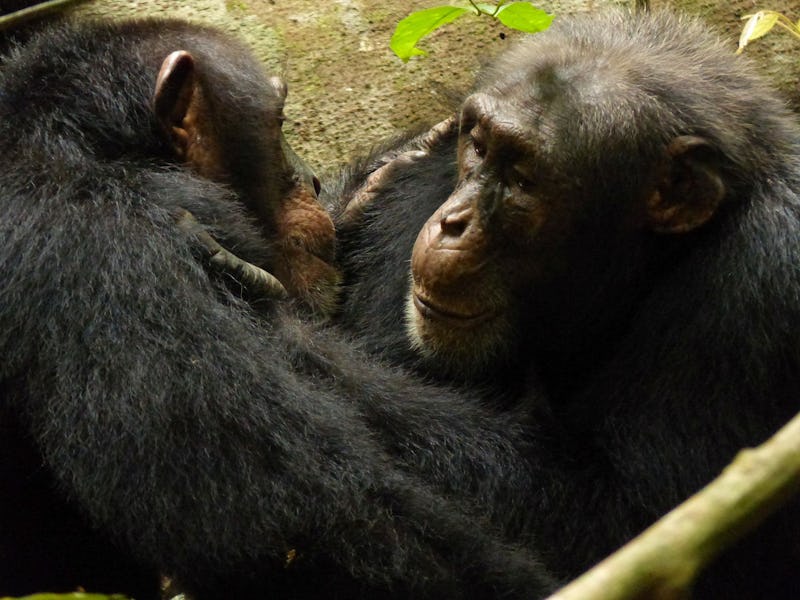Chimp Behaviors, Passed Down Over Generations, Are Starting to Disappear
Scientists are no longer seeing the behaviors they've documented for years.

Chimps and humans share 99 percent of our DNA, not to mention a common ancestor. Recent research has made it clear that there are numerous parallels between us, one of the most noteworthy being that we both have vibrant cultures. However, new research demonstrates that chimp culture, rich with unique forms of communication, game-playing, and food gathering, is in decline. Ironically, the damage is a result of human culture.
Human activity is currently driving a decline in great ape populations at a rate of 2.5 to 6 percent per year. In a study published Thursday in Science, an international team of scientists reveals that chimpanzees are experiencing a drastic reduction in their behavioral diversity. It has been reduced by 88 percent in locations where human impact is highest, compared to the areas with the least human impact.
Co-author and Max Planck Institute for Evolutionary Anthropology postdoctoral researcher Ammie Kalan, Ph.D., tells Inverse that human destruction comes in many forms, including poaching, logging, mining, and large-scale plantations. These actions lead to the loss, degradation, and fragmentation of the chimps’ natural habitats. It’s no secret that chimp habitat and resources are being destroyed, but the new study documents the damage being done to the less tangible parts of their lives.
“This likely occurs due to the disruption in social learning and cultural transmission processes needed for young chimpanzees to learn from others,” Kalan explains. This disruption can mean that behaviors are no longer passed on to the next generation and that these behaviors can become obsolete under new, changing environments.
Chimpanzees, like other socially intelligent animals, exhibit group-specific behaviors that are socially learned and passed on from one individual to another. Kalan explains that cultural behaviors in chimpanzees include nut cracking, termite fishing, leaf sponging, accumulative stone throwing, and algae fishing. There’s tremendous variation across chimpanzees in their group behavior, which is evidence of their unique cultures. Kalan personally most fascinated by cultural behaviors that are communicative in function, since these are the most socially relevant.
“For example, chimpanzees leaf clip for different reasons in different populations,” Kalan says, describing the expressive gesture in which a chimp takes bites of leaves while making a loud popping sound. “Some populations have strange behaviors such as accumulative stone throwing, which appears to be for communication, but it’s not yet clear. I am currently investigating some of these behaviors more closely.”
Kalan and her colleagues compiled a data set that included these behaviors along with environmental, social, and demographic behaviors. Overall the data — which included new field observations in Uganda as well as past research — documented chimps within 144 communities across Africa acting out 31 examples of behaviors. They also measured for levels of human impact — like human population density, the existence of roads, and cut-back forest cover.
The areas where human impact was highest also turned out to be places where there was the least amount of chimpanzee behavioral diversity. The why of this effect is a multi-pronged answer: It could be that, like Kalan explained, population plays a major role in maintaining cultural traits — chimpanzee communities are made up of individuals who exist within a specific geographic location, and it’s likely that when there are fewer chimps at that location, it’s more difficult to maintain cultural traits. That’s been previously shown for humans, so it’s fair to say it could be true for chimps.
Researchers also hypothesize that as humans move in closer to chimps, they may reduce the frequency of conspicuous behaviors like nut-cracking in an effort to not be noticed. Habitat degradation and resource depletion also make it more difficult for communities to grow, reducing opportunities for social learning.
Lastly, climate change may be contributing to the decline in chimp culture because it impacts the production of important food resources — it’s harder to nut crack (a cultural behavior witnessed in West Africa) when climate change is hurting the availability of the nuts.
This study, the authors argue, is evidence that specific interventions are needed to protect the natural resources and tool-sites utilizes by chimpanzees. They make the case for “chimpanzee cultural heritage sites” — regions unique to the cultural diversity of chimps that, when protected, can “safeguard their capacity for cultural evolution.” There’s still a limited understanding of the local traditions of chimps. The fear is that humans won’t learn enough to help until it is too late.
“We hope that this study will promote the incorporation of behavioral and cultural diversity into chimpanzee conservation management plans, and similarly for other culturally rich taxa like cetaceans and orangutans,” Kalan says. “In addition to viable population sizes and genetic diversity, we should consider protecting unique animal behaviors and cultures as well before they too disappear.”
Abstract:
Chimpanzees possess a large number of behavioral and cultural traits among non-human species. The ‘disturbance hypothesis’ predicts that human impact depletes resources and disrupts social learning processes necessary for behavioral and cultural transmission. We used an unprecedented data set of 144 chimpanzee communities, with information on 31 behaviors, to show that chimpanzees inhabiting areas with high human impact have a mean probability of occurrence reduced by 88%, across all behaviors, compared to low impact areas. This behavioral diversity loss was evident irrespective of the grouping or categorization of behaviors. Therefore, human impact may not only be associated with the loss of populations and genetic diversity but also affects how animals behave. Our results support the view that ‘culturally significant units’ should be integrated into wildlife conservation.